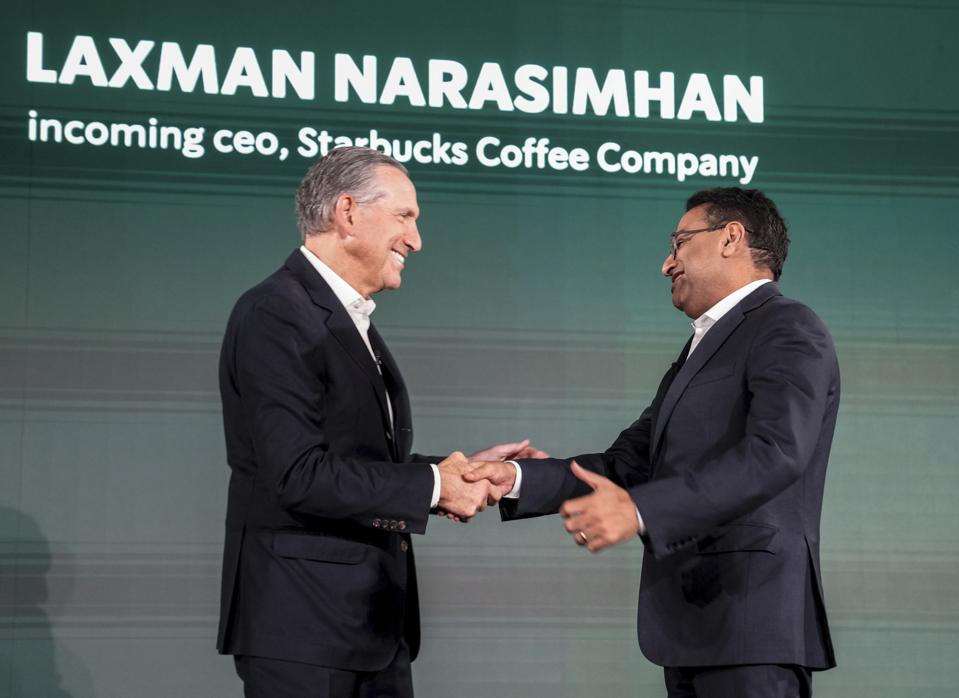
When Starbucks’ incoming CEO, Laxman Narasimhan, joined the company last October, he made an interesting (but very deliberate) choice about where to spend his time.
Narasimhan donned one of the company’s signature green aprons and proceeded to attend 40 hours of training to become a certified Starbucks barista. When he officially took over the reins as CEO in March, Narasimhan indicated that he’d continue to serve as a barista for four hours a month, each time in a different Starbucks location. (He also pointedly noted that he expected his senior executives to do the same.)
How and where a new CEO (or any leader, for that matter) spends their time says a lot about their priorities. You’ll typically find new, public company CEOs visiting with institutional investors, meeting with Wall Street analysts, huddling with the Board of Directors, etc. But attending a full week of frontline staff training? That’s generally not on the CEO’s radar.
But perhaps it should be – because when a leader truly immerses themselves in the life of frontline employees, the benefits are quite significant:
First, such an action sends an unmistakable signal to the workforce.
We’re not talking about a leader going on a multi-city listening tour and holding a few employee focus groups (though that’s beneficial, too). Rather, we’re talking about a leader dedicating material time (a full workweek, in Narasimhan’s case) just to learning the trade that is at the heart of their business.
Whether it’s a week of full on training, or just shadowing sessions with frontline staff, the outcome is the same: The workforce sees a leader who’s taking time to learn the intricacies of the operation, to understand what it feels like to be on the frontline, and to get a first-hand view of what it really takes to serve the company’s customers. That’s the kind of interested and informed leader that people are more likely to follow.
Second, it fosters a more customer-centric and collaborative culture.
When leaders get their hands dirty, whether it’s Narasimhan making cappuccinos for drive-thru customers, or a financial services CEO taking incoming 800-line calls – these small acts have undeniable cultural significance.
They are acts that underscore the importance of everyone orienting themselves around the customer. They are acts that help dismantle rigid organizational hierarchies by showing the workforce that no job is too menial — that everyone, regardless of role, chips in to serve the customer. They are acts that create a powerful esprit de corps, rallying people around a leader who they see as accessible rather than aloof.
And, third, it reveals opportunities to improve both the customer and employee experience.
There is simply no substitute for a senior leader stepping into the shoes of a frontline worker and seeing, first-hand, the “gauntlet” they must navigate to effectively serve customers — be it in the form of archaic systems, poorly-defined procedures, bureaucratic policies, disempowered job designs, overly complex products, or some other obstacle. Narasimhan, for example, witnessed how Starbucks’ plethora of cup and lid pairings complicates the barista’s job. He’s now working on simplifying that.
Leaders might read about these impediments in a management report, or hear about them in a staff meeting, but the gravity of these obstacles really only becomes apparent when you see them with your own eyes and experience the ensuing frustration. It is an exercise that creates a sense of empathy and urgency, motivating leaders to forge a work environment that liberates the staff from such hindrances.
* * *
One of the most valuable currencies for any leader is their time. Frequently, however, when leaders think about capitalizing on that currency, they focus on pruning their schedule – carving out more time for reflection, sending representatives to meetings, delegating tasks to others.
But redeeming that currency, and using it to more strongly engage the workforce, is something that’s often best accomplished by adding to one’s schedule, as Laxman Narasimhan did when he chose to attend barista training (and as he continues to do today by assuming the barista role once a month).
Every leader would be wise to follow Narasimhan’s example, because you don’t build trust with employees from the comfort of your corner office. Rather, you need to step into their shoes, see the world from their perspective, and show them how invested you are in their success.
[A version of this article originally appeared on Forbes.com.]
Jon Picoult is founder of Watermark Consulting, a customer experience advisory firm that helps companies impress customers and inspire employees, creating raving fans that drive business growth. Author of “FROM IMPRESSED TO OBSESSED: 12 Principles for Turning Customers and Employees into Lifelong Fans,” Picoult is an acclaimed public speaker, as well as an advisor to some of world’s foremost brands. Follow Jon on Twitter or Instagram, or subscribe to his monthly eNewsletter.